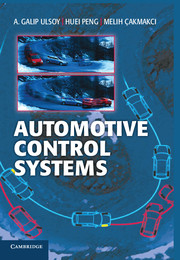Book contents
- Frontmatter
- Contents
- Preface
- Part I Introduction and Background
- Part II Powertrain Control Systems
- Part III Vehicle Control Systems
- 12 Cruise and Headway Control
- 13 Antilock Brake and Traction-Control Systems
- 14 Vehicle Stability Control
- 15 Four-Wheel Steering
- 16 Active Suspensions
- Part IV Intelligent Transportation Systems
- Appendices
- Index
- References
13 - Antilock Brake and Traction-Control Systems
Published online by Cambridge University Press: 05 June 2012
- Frontmatter
- Contents
- Preface
- Part I Introduction and Background
- Part II Powertrain Control Systems
- Part III Vehicle Control Systems
- 12 Cruise and Headway Control
- 13 Antilock Brake and Traction-Control Systems
- 14 Vehicle Stability Control
- 15 Four-Wheel Steering
- 16 Active Suspensions
- Part IV Intelligent Transportation Systems
- Appendices
- Index
- References
Summary
Antilock brake systems (ABS) were first introduced on railcars at the beginning of the 20th century. The original motivation was to avoid flat spots on the steel wheels; however, it soon was noted that stopping distance also was reduced by the ABS. Robert Bosch received a patent for ABS in 1936. In 1948, a Boeing B-47 was equipped with ABS to test its effectiveness in avoiding tire blowout on dry concrete and spinouts on icy runways. It used a “bang-bang” (i.e., dump brake pressure to zero, then rebuild) control strategy. Fully modulating ABS control strategies were introduced in the 1950s (e.g., Ford Lincoln, Goodyear, and HydroAire). A rear-wheels-only ABS was first available in luxury automobiles in the late 1960s. The systems used in the 1960s and 1970s were developed by Bendix, Kelsey-Hayes, and AC Electronics, among others. Legal concerns then delayed further development in the United States, and European companies took the lead in the next two decades. Demand skyrocketed in the early 1990s when the benefits of ABS for vehicle-steering control and shorter stopping distances were recognized and accepted widely. Most new passenger vehicles sold in the United States today are equipped with ABS. It is important to note that ABS will not work properly if the user input or road condition varies quickly. For example, according to a recent test report by the NHTSA (Forkenbrock et al. 1999), all of the test vehicles equipped with ABS stop within a longer distance than those without ABS on loose-gravel roads. Therefore, improvements still are needed in this relatively mature technology.
- Type
- Chapter
- Information
- Automotive Control Systems , pp. 232 - 256Publisher: Cambridge University PressPrint publication year: 2012

